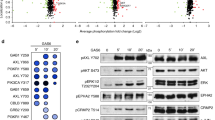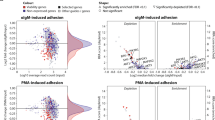Abstract
Adhesion turnover is critical for cell motility and invasion. We previously demonstrated that the adaptor molecule breast cancer antiestrogen resistance 3 (BCAR3) promotes adhesion disassembly and breast tumor cell invasion. One of two established binding partners of BCAR3 is the adaptor molecule, p130Cas. In this study, we sought to determine whether signaling through the BCAR3–Cas complex was responsible for the cellular functions of BCAR3. We show that the entire pool of BCAR3 is in complex with Cas in invasive breast tumor cells and that these proteins colocalize in dynamic cellular adhesions. Although accumulation of BCAR3 in adhesions did not require Cas binding, a direct interaction between BCAR3 and Cas was necessary for efficient dissociation of BCAR3 from adhesions. The dissociation rates of Cas and two other adhesion molecules, α-actinin and talin, were also significantly slower in the presence of a Cas-binding mutant of BCAR3, suggesting that turnover of the entire adhesion complex was delayed under these conditions. As was the case for adhesion turnover, BCAR3–Cas interactions were found to be important for BCAR3-mediated breast tumor cell chemotaxis toward serum and invasion in Matrigel. Previous work demonstrated that BCAR3 is a potent activator of Rac1, which in turn is an important regulator of adhesion dynamics and invasion. However, in contrast to wild-type BCAR3, ectopic expression of the Cas-binding mutant of BCAR3 failed to induce Rac1 activity in breast cancer cells. Together, these data show that the ability of BCAR3 to promote adhesion disassembly, tumor cell migration and invasion, and Rac1 activity is dependent on its ability to bind to Cas. The activity of BCAR3–Cas complexes as a functional unit in breast cancer is further supported by the co-expression of these molecules in multiple subtypes of human breast tumors.
This is a preview of subscription content, access via your institution
Access options
Subscribe to this journal
Receive 50 print issues and online access
$259.00 per year
only $5.18 per issue
Buy this article
- Purchase on Springer Link
- Instant access to full article PDF
Prices may be subject to local taxes which are calculated during checkout








Similar content being viewed by others
References
Riggins RB, Quilliam LA, Bouton AH . Synergistic promotion of c-Src activation and cell migration by Cas and AND-34/BCAR3. J Biol Chem 2003; 278: 28264–28273.
Schrecengost RS, Riggins RB, Thomas KS, Guerrero MS, Bouton AH . Breast cancer antiestrogen resistance-3 expression regulates breast cancer cell migration through promotion of p130Cas membrane localization and membrane ruffling. Cancer Res 2007; 67: 6174–6182.
Sun G, Cheng SY, Chen M, Lim CJ, Pallen CJ . Protein tyrosine phosphatase alpha phosphotyrosyl-789 binds BCAR3 to position Cas for activation at integrin-mediated focal adhesions. Mol Cell Biol 2012; 32: 3776–3789.
Wilson AL, Schrecengost RS, Guerrero MS, Thomas KS, Bouton AH . Breast cancer antiestrogen resistance 3 (BCAR3) promotes cell motility by regulating actin cytoskeletal and adhesion remodeling in invasive breast cancer cells. PloS One 2013; 8: e65678.
Wallez Y, Riedl SJ, Pasquale EB . Association of the breast cancer antiestrogen resistance protein 1 (BCAR1) and BCAR3 scaffolding proteins in cell signaling and antiestrogen resistance. J Biol Chem 2014; 289: 10431–10444.
Lu Y, Brush J, Stewart TA . NSP1 defines a novel family of adaptor proteins linking integrin and tyrosine kinase receptors to the c-Jun N-terminal kinase/stress-activated protein kinase signaling pathway. J Biol Chem 1999; 274: 10047–10052.
Cai D, Clayton LK, Smolyar A, Lerner A . AND-34, a novel p130Cas-binding thymic stromal cell protein regulated by adhesion and inflammatory cytokines. J Immunol 1999; 163: 2104–2112.
Vervoort VS, Roselli S, Oshima RG, Pasquale EB . Splice variants and expression patterns of SHEP1, BCAR3 and NSP1, a gene family involved in integrin and receptor tyrosine kinase signaling. Gene 2007; 391: 161–170.
Mace PD, Wallez Y, Dobaczewska MK, Lee JJ, Robinson H, Pasquale EB et al. NSP-Cas protein structures reveal a promiscuous interaction module in cell signaling. Nat Struct Mol Biol 2011; 18: 1381–1387.
Cabodi S, del Pilar Camacho-Leal M, Di Stefano P, Defilippi P . Integrin signalling adaptors: not only figurants in the cancer story. Nat Rev Cancer 2010; 10: 858–870.
Schuh NR, Guerrero MS, Schrecengost RS, Bouton AH . BCAR3 regulates Src/p130Cas association, Src kinase activity, and breast cancer adhesion signaling. J Biol Chem 2010; 285: 2309–2317.
Parsons JT, Horwitz AR, Schwartz MA . Cell adhesion: integrating cytoskeletal dynamics and cellular tension. Nat Rev Mol Cell Bio 2010; 11: 633–643.
Webb DJ, Donais K, Whitmore LA, Thomas SM, Turner CE, Parsons JT et al. FAK-Src signalling through paxillin, ERK and MLCK regulates adhesion disassembly. Nat Cell Biol 2004; 6: 154–161.
Broussard JA, Webb DJ, Kaverina I . Asymmetric focal adhesion disassembly in motile cells. Curr Opin Cell Biol 2008; 20: 85–90.
Kenny PA, Lee GY, Myers CA, Neve RM, Semeiks JR, Spellman PT et al. The morphologies of breast cancer cell lines in three-dimensional assays correlate with their profiles of gene expression. Mol Oncol 2007; 1: 84–96.
Near RI, Zhang Y, Makkinje A, Vanden Borre P, Lerner A . AND-34/BCAR3 differs from other NSP homologs in induction of anti-estrogen resistance, cyclin D1 promoter activation and altered breast cancer cell morphology. J Cell Physiol 2007; 212: 655–665.
Klemke RL, Leng J, Molander R, Brooks PC, Vuori K, Cheresh DA . CAS/Crk coupling serves as a "molecular switch" for induction of cell migration. J Cell Biol 1998; 140: 961–972.
Akakura S, Kar B, Singh S, Cho L, Tibrewal N, Sanokawa-Akakura R et al. C-terminal SH3 domain of CrkII regulates the assembly and function of the DOCK180/ELMO Rac-GEF. J Cell Physiol 2005; 204: 344–351.
Yamazaki D, Kurisu S, Takenawa T . Involvement of Rac and Rho signaling in cancer cell motility in 3D substrates. Oncogene 2009; 28: 1570–1583.
Harunaga JS, Yamada KM . Cell-matrix adhesions in 3D. Matrix Biol 2011; 30: 363–368.
Petrie RJ, Yamada KM . At the leading edge of three-dimensional cell migration. J Cell Sci 2012; 125: 5917–5926.
Vanden Borre P, Near RI, Makkinje A, Mostoslavsky G, Lerner A . BCAR3/AND-34 can signal independent of complex formation with CAS family members or the presence of p130Cas. Cell Signal 2011; 23: 1030–1040.
Near RI, Smith RS, Toselli PA, Freddo TF, Bloom AB, Vanden Borre P et al. Loss of AND-34/BCAR3 expression in mice results in rupture of the adult lens. Mol Vis 2009; 15: 685–699.
Bouton AH, Burnham MR . Detection of distinct pools of the adapter protein p130CAS using a panel of monoclonal antibodies. Hybridoma 1997; 16: 403–411.
Acknowledgements
The authors thank Jessica Zareno for technical assistance with TIRF microscopy and Dr Kristen Atkins for identification and pathological assessment of human breast tumor samples. This work was supported by grants from the NIH (5 T32 CA009109 (ALW, AMC), 1 R01 CA096846 (AHB), 1 F31 CA165703 (ALW), 1 F31 CA130168 (MSG) and GM023244 (ARH)); the Department of Defense Breast Cancer Research Program (BC141713 to AHB); the American Cancer Society (PF-12-136-01-CSM to KEK); and the Women’s Oncology Research Fund and NCI Cancer Center Support Grant P30 CA44579 from the UVA Cancer Center. Breast tumor samples were obtained from the UVA tumor bank and stained by the Biorepository and Tissue Research Facility (BTRF).
Author information
Authors and Affiliations
Corresponding author
Ethics declarations
Competing interests
The authors declare no conflict of interest.
Additional information
Supplementary Information accompanies this paper on the Oncogene website
Supplementary information
Rights and permissions
About this article
Cite this article
Cross, A., Wilson, A., Guerrero, M. et al. Breast cancer antiestrogen resistance 3–p130Cas interactions promote adhesion disassembly and invasion in breast cancer cells. Oncogene 35, 5850–5859 (2016). https://doi.org/10.1038/onc.2016.123
Received:
Revised:
Accepted:
Published:
Issue Date:
DOI: https://doi.org/10.1038/onc.2016.123
This article is cited by
-
BCAR3 promotes head and neck cancer growth and is associated with poor prognosis
Cell Death Discovery (2021)
-
Prediction and prognostic significance of BCAR3 expression in patients with multiple myeloma
Journal of Translational Medicine (2018)



